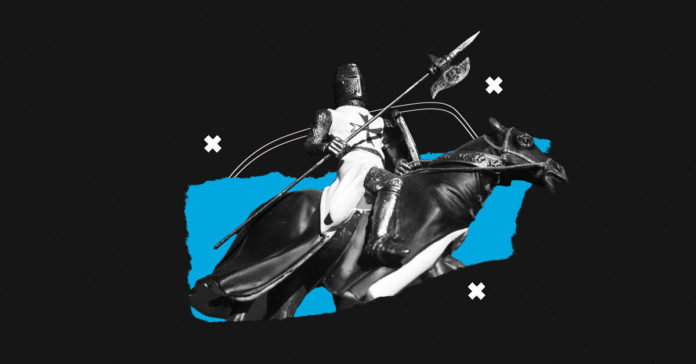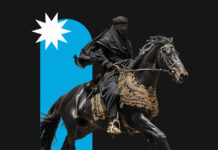The crusades are a very good example of how a distorted, negative image of the Muslim foe was built so as to help accomplish the objectives pursued by the Christian West.
Firstly it was necessary to build the image of the barbaric, mass murdering Muslims to stir the Christians into action. In launching the crusades (in 1095), Pope Urban II (Pope 1088-1099) spoke of:
‘An accursed race, a race utterly alienated from God… has invaded the lands of those Christians and has depopulated them by the sword, pillage and fire… They (the Turks) perforate navels… (and inflict terrible cruelties on the Christians, depicted in great detail by the Pope) …. What shall I say of the abominable rape of the women? …. Accordingly undertake this journey for the remission of your sins, with the assurance of the imperishable glory of the kingdom of heaven.’[1]
By this speech, Urban legitimised Christian aggression, making it for the whole Western community a case ‘of kill or be killed’[2]
To spread this message, Finucane notes, priests and prelates in different styles and tones, exercised ‘all the tricks of the orator’s trade, cajoling, threatening, promising; using allegory, hyperbole, anaphora; rousing with revenge motifs.’[3] Thus, Balderic (Baldricus), archbishop of Doi, goes:
‘We have heard, most beloved brethren, and you have heard what we cannot recount without deep sorrow how, with great hurt and dire sufferings our Christian brothers, members in Christ, are scourged, oppressed, and injured in Jerusalem, in Antioch, and the other cities of the East ….. Base and bastard Turks hold sway over our brothers.’[4]
The Turks according to Fulcher of Chartres, ‘Have killed and captured many, have destroyed the churches and devastated the Kingdom of God.’[5]
For Guibert of Nogent, unspeakable cruelty has been inflicted on the pilgrims; ‘remember, I pray you, the thousands who have perished vile deaths.’[6]
‘All atrocities,’ Munro points out, ‘highly spiced to suit the spirit of the time, and influence the Christians to take up arms, inciting many to take the Cross and flock to the Holy Land for revenge.’[7]
And so the hordes departed to inflict revenge: ‘Clergy, nobles, all the people, the chaste, the incestuous, the adulterers, robbers, all who professed the Christian faith,’ grasped the opportunity for penance, and went on the crusade.[8] They ’emerged in bands on all sides,’ equipped themselves with food and arms that they needed to get to Jerusalem,’ says Albert of Aix, and were ‘burning with fire and divine love.’[9]
Once reaching the Muslim East, they committed terrible atrocities such as when they took Ma’arrat an-Nu’man in 1098. The terrified population hid in their homes, but to no avail. For three days the slaughter never stopped; the crusaders killed more than 100,000 people.[10] The chronicler of nearby Aleppo, Ibn al-Adim (d. 1262), speaks of the carnage:
‘They (the Franks) killed a great number under torture. They extorted people’s treasures. They prevented people from (getting) water, and sold it to them. Most of the people died of thirst… No treasure remained there that was not extorted by them. They destroyed the walls of the town, burned its mosques and houses and broke the minbars.’[11]
Christian sources, present at the scene, were more descriptive. Robert the Monk says:
‘Our men walked through the roads, places, on the roofs, and feasted on the slaughter just like a lioness who had her cubs taken from her. They cut into pieces, and put to death children, the young, and the old crumbling under the weight of the years. They did that in groups … Our men grabbed everybody who fell in their hands. They cut bellies open, and took out gold coins. Oh detestable cupidity of gold! Streams of blood ran on the roads of the city; and everywhere lay corpses. Oh blinded nations and destined to death; none of that multitude accepted the Christian faith. At last Bohemond brought out all those he had first invited to lock themselves in the tower of the place. He ordered that all old women be put to death, and also old men, whose age had rendered useless; then all the rest he ordered to be taken to Antioch to be sold as slaves. This massacre of the Turks took place on 12 December; on Sunday; but on this day not all work could be accomplished; so the following day our men killed all the rest.’[12]
Radulph of Caen said how:
“In Maarra our troops boiled pagan adults in cooking pots; they impaled children on spits and devoured them grilled.”[13]
In fact, as the chronicler, William of Tyre notes, it was a common practice for the crusaders to roast and eat the flesh of the Muslims they slew.[14] The daughter of the Byzantine Emperor, Anna Comnena, accused Peter the Hermit’s followers of chopping up babies and impaling others on spits to roast over fires, while the elderly were subjected to a variety of tortures.[15] At Ma’arra, to avoid such a fate, many Muslims were said by a Christian writer to have jumped down wells to their deaths.[16]
These massacres were generalised to all towns and cities taken by the crusaders, from Antioch, to Jerusalem to Caesarea … , and lasted for more than a century. Then, in the 1250s, in alliance with the Mongols, the Christians threatened to exterminate the whole Muslim entity.[17] Had it not been for the Seljuk and Mamluk fight-back, principally, the Muslims would have been extinguished.[18] It is likely that over ten million Muslims were slaughtered by both crusaders and Mongols.[19]
Other than the annihilation of Muslims, there were other aims. Firstly, the Catholic Church wanted to unite both Western and Eastern Churches. Pope Urban’s Speech at the Council of Clermont in 1095, which summoned the crusaders against the Muslims, followed the crushing of the Byzantine armies in 1071 by the Seljuk Turks at Manzikert, and the promises made by the Byzantine emperor to the Catholic Church for reunification. Pope Urban knew that by coming to the rescue of the Byzantine emperor, he could unify both Churches under him.[20]
A second reason for the crusades, as Durant explains, was the ambition of the Italian cities-Pisa, Genoa, Venice, Amalfi to extend their rising commercial power.[21] This followed the Norman capture of Sicily from the Muslims (1090), and Christians progress in Spain (the capture of Toledo in 1085), which freed the western Mediterranean for Christian trade; and the Italian cities sought to end Muslim ascendancy in the eastern Mediterranean, and open the markets of the Near East to Western European goods. We do not know, Durant says, how close these Italian merchants were to the ear of the Pope.[22]
A third reason was that the Christian West was at war with itself, and for a century before the crusades attempts were made to limit the effects of domestic warfare.[23] Fighting a common enemy, Islam, it was concluded, was a unifying element. Urban, besides, was not blind either to the advantage accruing to Western society if the warlike energies of the lesser baronage were deflected East.[24]
Fourthly, as one contemporary put into the mouth of Urban at Clennont in 1095, the explicit statement that there was not enough land in the West:
‘This land you inhabit. . . is overfilled by numbers; it does not abound in wealth: it supplies scarcely enough food for those who farm it; hence it is that you fight and devour each other, that you wage wars and often perish by mutual blows.’[25]
This was a shared belief amongst all echelons of the departing crusaders. The main crusader leader, Godfrey of Bouillon, was accompanied by a brother, Baldwin, and the other leader, Bohemond, by a nephew, Tancred, who hoped to make their fortunes overseas.[26] Bohemond of Tarento went for no reason other than the desire to found a principality in the East, and Raymond of St.Gilles, that other leader, also had an eye for the fair lands of Syria.[27]
‘Everyone sought a piece of the gains of this earth. The poor were so anxious for a chance to strike it rich that, once the killing began, ‘they were scrabbling for the spoils while the knights were still killing the Turks.’[28]
However, the main aim, by far, behind the crusades, was that this was the best time to destroy the Muslim foe once and for all. The Muslim world was in a chaotic state prior to Urban’s call for the crusades. Sicily had just been lost by the Muslims to the Nonnans (1089-90). The Spanish re-conquista was now moving ahead (taking of Toledo in 1085). Even more interestingly from a Christian point of view, the Muslim East was in chaos. There were wars between the Sunnis and Shias, i.e. Seljuks and Fatimids, which had split the Muslim world right down the middle. The Muslim leadership has also been murdered. In 1092 the greatest f igure of Seljuk history, Nizam al-Mulk, the facto the ruler of the Seljuk Empire for over thirty years, was murdered.[29] A month later, Malik Shah, the third Seljuk sultan, died in suspicious circumstances, after a successful twenty-year reign, his death followed closely by that of his wife, grandson and other powerful political figures.[30] Leaderless, the Islamic world was ridden with internal strife; 11th century Syria, Lamonte notes, was ‘a crazy quilt of semi independent states.[31] The Islamic world was thus in no position to fend off the attacks from Western Europe which were about to occur.[32] The timing of the First Crusade, Hillenbrand notes, simply could not have been more propitious:
‘Had the Europeans somehow been briefed that this was the perfect moment to pounce? Unfortunately there is little evidence on this in the Islamic sources, but seldom had the arm of coincidence been longer.’[33]
It was, indeed, the best of times to secure the main objective of Western Christendom, ‘An overriding motive to destroy the Muslim creed, to annihilate lslam.’[34] To do this, however, the essential ingredient was required: Muslim aggression, and thus Pope Urban’s speech.
[The Myth of Muslim Barbarism and Its Aims by S.E. Al-Djazairi, p.324-329]
Notes:
[1] In D. C. Munro, “Urban and the Crusaders”, Translations and Reprints from the Original Sources of European History, Vo! I :2, 1895, pp. 5-8.
[2] N. Daniel: The Cultural; op cit; p.1 58.
[3] R. Finucane: Soldiers of the Faith; (J.M. Dent and Sons Ltd; London, 1983); p.30.
[4] In A. C. Krey, The First Crusade: The Accounts of Eyewitnesses and Participants, (Princeton University Press; 1921 ); pp 33-36.
[5] D.C. Munro: The Western attitude; op cit; at p.329.
[6] In N. Daniel: The Arabs, op cit; p.253.
[7] D.C. Munro: The Western; op cit; p. 329.
[8] N. Daniel: The Arabs; op cit; p.122.
[9] Ibid; p.123.
[10] Ibn al-Athir: Kitab al-Kami/; ed K.J. Tornberg; 12 vols; (Leiden; 1851-72). X; p. 190.
[11] In Y.Tabba: Monuments with a message, in The Meeting of Two Worlds; Ed V.P. Goss; (Kalamazoo; Michigan; 1986); pp. 223-40; at p. 233.
See Kemal Eddin: Muntakhabat min Tarikh Halab; in Receui/ des Historiens Orientaux; (Paris; 1872); ff. vol iii; pp. 586-7.
[12] Robert the Monk, in G. Le Bon: La Civilisation, op cit; p. 248.
[13] In Janet Abu Lughod: Before European Hegemony; (Oxford University Press; 1989); p. 107.
[14] C.R. Conder: The Latin Kingdom; op cit. p. 45.
[15] The Alexiad of Anna Comnena, tr. E.R. A. Sewter; (Harrnondsworth; 1969); pp. 311; 437.
[16] R. Finucane: Soldiers of the Faith; op cit; p.106;
[17] Baron G. D’Ohsson: Histoire des Mongols, in four volumes; (Les Freres Van Cleef; la Haye and Amsterdam; 1834). J.J. Saunders: Aspects of the Crusades, op cit. 1
[18] Ibn al-Qalanisi: Day/ tarikh Dimashk; ed. H.F. Amedroz; (Leiden; 1908). Herbert. M. J. Loewe: The Seljuqs: in The Cambridge Medieval History, op cit; pp 299-317. Ibn al-Furat: Tarikh al-Duwal wal Muluk; ed. M. F. El-Shayyal; unpublished Ph.d.; University of Edinburgh; 1986.
[19] A.N Poliak: The Demographic Evolution of the Middle East: population trends since 1348, Palestine and the Middle East, vol X. no 5, 1938. E.G. Browne: Literary History of Persia; (Cambridge University Press; 1929). Baron G. D’Ohsson: Histoire des Mongols, op cit;
[20] D. Hay: The Medieval Centuries; (Methuen and Co; London; 1964 ); p. 90.
[21] W. Durant: The Age of Faith; op cit; p. 586.
[22] Ibid.
[23] D. Hay: The Medieval Centuries; op cit; p. 90.
[24] Ibid.
[25] Ibid; p. 81.
[26] Ibid; p. 91.
[27] J.H. Lamonte: Crusade and Jihad: in The Arab Heritage, N.A. Faris ed: (Princeton University Press, 1944 ); pp 159-98. p.162.
[28] R. Finucane: Soldiers of the Faith; op cit; p.79.
[29] W. Durant: The Age of Faith, op cit; Chapter XIV; p.309.
[30] C. Hillenbrand: The Crusades; op cit; p.33.
[31] J.H. Lamonte: Crusade and Jihad: op cit; p.163.
[32] C. Hillenbrand: The Crusades, op cit; p. 18
[33] Ibid; p.33.
[34] C. Bennett: Victorian Images of Islam; (Grey Seal; London; 1992); p. 6.









